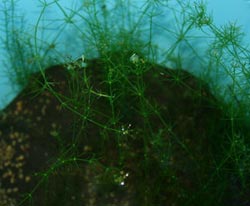Giant cell reveals metabolic secrets

Figure 1: The freshwater alga Chara australis, which has giant cells ideal for cell biology studies. Copyright : 2012 Akira Oikawa<br>
Chemical reactions within the cell produce intermediate and end products in the form of small molecules called metabolites. Using an approach called metabolomics, a research team led by Kazuki Saito of the RIKEN Plant Science Center, Yokohama and Tsuruoka, has elucidated the localization and dynamics of 125 metabolites within a single giant cell of the freshwater alga Chara australis1. The team’s findings provide important insights into the fundamental processes of cells in general.
Metabolites play important roles in the regulation of critical biological processes, such as growth, differentiation, and, in the case of so-called ‘secondary metabolites’, chemical defense. “Metabolomics is the systematic study of these unique chemical footprints, and involves identifying and characterizing the many metabolites found in a cell, tissue, organ or organism, as well as their production, distribution and dynamics,” explains Saito.
Because the enzymes involved in producing and converting different metabolites are often localized within subcellular structures called organelles, biologists generally assumed that metabolites are also highly compartmentalized within the cell, but none had demonstrated this comprehensively.
“Understanding the compartmentalization and dynamics of metabolites within single organelles represents an enormous technical challenge, not least because of the tiny size of these structures in most cells,” says Saito.
He and his colleagues therefore turned to C. australis as a model system (Fig. 1). This species has a particular cell type, called an internodal cell, which can grow to a length of around 20 centimeters. Because of their large size and volume, internodal cells are widely used to study various aspects of cell biology, including membrane physiology. The researchers purified single vacuoles, a type of organelle, from these cells. They then used a battery of sophisticated metabolomic techniques to determine the localization and dynamics of metabolites in the vacuole and other cellular fractions collectively known as the cytoplasm.
Focusing on phosphate compounds, Saito and colleagues detected 125 known metabolites, and showed that they fluctuated independently in the vacuole and cytoplasm under various light conditions. They therefore concluded that metabolites are spatially regulated within the cell, moving between the vacuole and the cytoplasm according to conditions. “Ours is the first study to confirm specific compartmentalization of comprehensive metabolites in a single vacuole from a single cell,” notes Saito.
Using a specialized microinjection technique, they researchers also observed metabolite transport across the membrane surrounding the vacuole. This suggested to them that the vacuolar membrane plays an important role in regulating transport of metabolites in and out of the vacuole.
The corresponding author for this highlight is based at the Metabolomic Function Research Group, RIKEN Plant Science Center
Media Contact
All latest news from the category: Life Sciences and Chemistry
Articles and reports from the Life Sciences and chemistry area deal with applied and basic research into modern biology, chemistry and human medicine.
Valuable information can be found on a range of life sciences fields including bacteriology, biochemistry, bionics, bioinformatics, biophysics, biotechnology, genetics, geobotany, human biology, marine biology, microbiology, molecular biology, cellular biology, zoology, bioinorganic chemistry, microchemistry and environmental chemistry.
Newest articles

A universal framework for spatial biology
SpatialData is a freely accessible tool to unify and integrate data from different omics technologies accounting for spatial information, which can provide holistic insights into health and disease. Biological processes…

How complex biological processes arise
A $20 million grant from the U.S. National Science Foundation (NSF) will support the establishment and operation of the National Synthesis Center for Emergence in the Molecular and Cellular Sciences (NCEMS) at…

Airborne single-photon lidar system achieves high-resolution 3D imaging
Compact, low-power system opens doors for photon-efficient drone and satellite-based environmental monitoring and mapping. Researchers have developed a compact and lightweight single-photon airborne lidar system that can acquire high-resolution 3D…





















